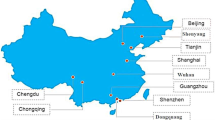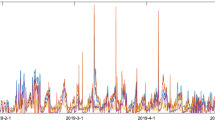Abstract
Over the past decades, air pollution has turned out to be a major cause of environmental degradation and health effects, particularly in developing countries like India. Various measures are taken by scholars and governments to control or mitigate air pollution. The air quality prediction model triggers an alarm when the quality of air changes to hazardous or when the pollutant concentration surpasses the defined limit. Accurate air quality assessment becomes an indispensable step in many urban and industrial areas to monitor and preserve the quality of air. To accomplish this goal, this paper proposes a novel Attention Convolutional Bidirectional Gated Recurrent Unit based Dynamic Arithmetic Optimization (ACBiGRU-DAO) approach. The Attention Convolutional Bidirectional Gated Recurrent Unit (ACBiGRU) model is determined in which the fine-tuning parameters are used to enhance the proposed method by Dynamic Arithmetic Optimization (DAO) algorithm. The air quality data of India was acquired from the Kaggle website. From the dataset, the most-influencing features such as Air Quality Index (AQI), particulate matter namely PM2.5 and PM10, carbon monoxide (CO) concentration, nitrogen dioxide (NO2) concentration, sulfur dioxide (SO2) concentration, and ozone (O3) concentration are taken as input data. Initially, they are preprocessed through two different pipelines namely imputation of missing values and data transformation. Finally, the proposed ACBiGRU-DAO approach predicts air quality and classifies based on their severities into six AQI stages. The efficiency of the proposed ACBiGRU-DAO approach is examined using diverse evaluation indicators namely Accuracy, Maximum Prediction Error (MPE), Mean Absolute Error (MAE), Mean Square Error (MSE), Root Mean Square Error (RMSE), and Correlation Coefficient (CC). The simulation result inherits that the proposed ACBiGRU-DAO approach achieves a greater percentage of accuracy of about 95.34% than other compared methods.











Similar content being viewed by others
Data availability
The data that support the findings of this study are available from the corresponding author upon reasonable request.
References
Bekkar A, Hssina B, Douzi S, Douzi K (2021) Air-pollution prediction in smart city, deep learning approach. J Big Data 8(1):1–21
Benhaddi M, Ouarzazi J (2021) Multivariate time series forecasting with dilated residual convolutional neural networks for urban air quality prediction. Arab J Sci Eng 46(4):3423–3442
Dairi A, Harrou F, Sun Y, Khadraoui S (2020) Short-term forecasting of photovoltaic solar power production using variational auto-encoder driven deep learning approach. Appl Sci 10(23):8400
Freeman BS, Taylor G, Gharabaghi B, Thé J (2018) Forecasting air quality time series using deep learning. J Air Waste Manag Assoc 68(8):866–886
Ge L, Wu K, Zeng Y, Chang F, Wang Y, Li S (2021) Multi-scale spatiotemporal graph convolution network for air quality prediction. Appl Intell 51(6):3491–3505
Guo Q, He Z (2021) Prediction of the confirmed cases and deaths of global COVID-19 using artificial intelligence. Environ Sci Pollut Res 28:11672–11682
Guo Q, He Z, Li S, Li X, Meng J, Hou Z, Liu J, Chen Y (2020) Air pollution forecasting using artificial and wavelet neural networks with meteorological conditions. Aerosol Air Qual Res 20(6):1429–1439
Guo Q, Wang Z, He Z, Li X, Meng J, Hou Z, Yang J (2021) Changes in air quality from the COVID to the post-COVID era in the beijing-tianjin-tangshan region in China. Aerosol Air Qual Res 21(12):210270
Guo Q, He Z, Wang Z (2023a) Predicting of daily PM2.5 concentration employing wavelet artificial neural networks based on meteorological elements in Shanghai, China. Toxics 11(1):51
Guo Q, He Z, Wang Z (2023b) Long-term projection of future climate change over the twenty-first century in the Sahara region in Africa under four Shared Socio-Economic Pathways scenarios. Environ Sci Pollut Res 30(9):22319–22329
He Z, Zhang Y, Guo Q, Zhao X (2014) Comparative study of artificial neural networks and wavelet artificial neural networks for groundwater depth data forecasting with various curve fractal dimensions. Water Resour Manag 28:5297–5317
He Z, Guo Q, Wang Z, Li X (2022) Prediction of monthly PM2.5 concentration in Liaocheng in China employing artificial neural network. Atmosphere 13(8):1221
Huang G, Wang D, Du Y, Zhang Q, Bai Z, Wang C (2022) Deformation Feature Extraction for GNSS Landslide Monitoring Series Based on Robust Adaptive Sliding-Window Algorithm. Frontiers in Earth Science 487.
Jin N, Zeng Y, Yan K, Ji Z (2021) Multivariate air quality forecasting with nested long short term memory neural network. IEEE Trans Industr Inf 17(12):8514–8522
Khodadadi N, Snasel V, Mirjalili S (2022) Dynamic arithmetic optimization algorithm for truss optimization under natural frequency constraints. IEEE Access 10:16188–16208
Kristiani E, Lin H, Lin JR, Chuang YH, Huang CY, Yang CT (2022) Short-term prediction of PM2. 5 using LSTM deep learning methods. Sustainability 14(4):2068
Li H, Wang J, Li R, Lu H (2019) Novel analysis–forecast system based on multi-objective optimization for air quality index. J Clean Prod 208:1365–1383
Lin YC, Lee SJ, Ouyang CS, Wu CH (2020) Air quality prediction by neuro-fuzzy modeling approach. Appl Soft Comput 86:105898
Liu H, Yan G, Duan Z, Chen C (2021) Intelligent modeling strategies for forecasting air quality time series: A review. Appl Soft Comput 102:106957
Liu J, Yang Y, Lv S, Wang J, Chen H (2019) Attention-based BiGRU-CNN for Chinese question classification. Journal of Ambient Intelligence and Humanized Computing 1-12.
Ma J, Cheng JC, Lin C, Tan Y, Zhang J (2019) Improving air quality prediction accuracy at larger temporal resolutions using deep learning and transfer learning techniques. Atmos Environ 214:116885
Ma J, Li Z, Cheng JC, Ding Y, Lin C, Xu Z (2020) Air quality prediction at new stations using spatially transferred bi-directional long short-term memory network. Sci Total Environ 705:135771
Maleki H, Sorooshian A, Goudarzi G, Baboli Z, Tahmasebi Birgani Y, Rahmati M (2019) Air pollution prediction by using an artificial neural network model. Clean Technol Environ Policy 21(6):1341–1352
Mao W, Wang W, Jiao L, Zhao S, Liu A (2021) Modeling air quality prediction using a deep learning approach: Method optimization and evaluation. Sustain Cities Soc 65:102567
Samal KKR, Babu KS, Acharya A, Das SK (2020) Long term forecasting of ambient air quality using deep learning approach. In 2020 IEEE 17th India Council International Conference (INDICON) (pp. 1-6). IEEE.
Tiwari A, Gupta R, Chandra R (2021) Delhi air quality prediction using LSTM deep learning models with a focus on COVID-19 lockdown. arXiv preprint arXiv:2102.10551.
Wang J, Song G (2018) A deep spatial-temporal ensemble model for air quality prediction. Neurocomputing 314:198–206
Xu X, Yoneda M (2019) Multitask air-quality prediction based on LSTM-autoencoder model. IEEE Trans Cybern 51(5):2577–2586
Zhang Y, Wang Y, Gao M, Ma Q, Zhao J, Zhang R, Wang Q, Huang L (2019) A predictive data feature exploration-based air quality prediction approach. IEEE Access 7:30732–30743
Zhang K, Thé J, Xie G, Yu H (2020) Multi-step ahead forecasting of regional air quality using spatial-temporal deep neural networks: a case study of Huaihai Economic Zone. J Clean Prod 277:123231
Zhang Z, Zeng Y, Yan K (2021) A hybrid deep learning technology for PM2.5 air quality forecasting. Environ Sci Pollut Res 28(29):39409–39422
Zhao G, Huang G, He H, He H, Ren J (2019) Regional spatiotemporal collaborative prediction model for air quality. IEEE Access 7:134903–134919
Zhu D, Cai C, Yang T, Zhou X (2018) A machine learning approach for air quality prediction: Model regularization and optimization. Big Data Cogn Comput 2(1):5
Zou X, Zhao J, Zhao D, Sun B, He Y, Fuentes S (2021) Air quality prediction based on a spatiotemporal attention mechanism. Mobile Information Systems 2021:1-12.
Author information
Authors and Affiliations
Contributions
All agreed on the content of the study. Vinoth Panneerselvam and Revathi Thiagarajan collected all the data for analysis. Vinoth Panneerselvam agreed on the methodology. Vinoth Panneerselvam and Revathi Thiagarajan completed the analysis based on agreed steps. Results and conclusions are discussed and written together. All authors read and approved the final manuscript.
Corresponding author
Ethics declarations
Ethics approval
This article does not contain any studies with human or animal subjects performed by any of the authors.
Informed consent
Informed consent was obtained from all individual participants included in the study.
Consent to participate
Not applicable.
Consent for publication
Not applicable.
Conflict of interest
The authors declare no competing interests.
Additional information
Responsible Editor: Marcus Schulz
Publisher's note
Springer Nature remains neutral with regard to jurisdictional claims in published maps and institutional affiliations.
Rights and permissions
Springer Nature or its licensor (e.g. a society or other partner) holds exclusive rights to this article under a publishing agreement with the author(s) or other rightsholder(s); author self-archiving of the accepted manuscript version of this article is solely governed by the terms of such publishing agreement and applicable law.
About this article
Cite this article
Panneerselvam, V., Thiagarajan, R. ACBiGRU-DAO: Attention Convolutional Bidirectional Gated Recurrent Unit-based Dynamic Arithmetic Optimization for Air Quality Prediction. Environ Sci Pollut Res 30, 86804–86820 (2023). https://doi.org/10.1007/s11356-023-28028-4
Received:
Accepted:
Published:
Issue Date:
DOI: https://doi.org/10.1007/s11356-023-28028-4




